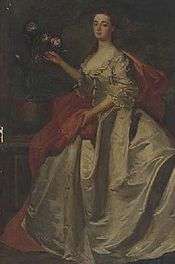Mary Howard, Duchess of Norfolk (d. 1773)


Mary Howard, Duchess of Norfolk (née Blount; c. 1712 – 1773), was the British noblewoman after whom Norfolk Island was named.
Early life
The youngest of three daughters of Edward Blount (d. 1726) and his wife Anne, née Guise, she was a co-heiress of her father's property.[1] Born into an exiled Roman Catholic family, she spent her adolescence and early years of marriage on the continent.[2] On 26 November 1727, she married Edward Howard. He succeeded to the dukedom in 1732, upon the death of his older brother Thomas.
Activities

The pair were socially active, using their position as the highest ranking peers in the kingdom to promote religious tolerance. As Roman Catholics whose immediate predecessors, the 8th Duke and his wife Maria, supported the Jacobite rising of 1715, Mary and Edward Howard were keen to express their support of the Protestant King George II. The Duchess was intelligent and assertive; she was referred to as "My Lord Duchess" by Horace Walpole. Her interest in arts drove her to restore the Norfolk House in 1755.[1] An ardent Catholic, she was very fond of French and Italian fashion and styles, employing Giovanni Battista Borra to decorate the residence. The newly built Music Room, intended for the playing of music, was a particularly important part of the Norfolk House, as the Duchess used it for receptions, but contained no musical instruments.[3]
She proceeded to have Worksop Manor renovated. After the manor burned down in 1761, the Duchess had it restored once again.[4] The childless couple had decided to rebuild the house for the benefit of their nephew Thomas, heir presumptive to the dukedom. Further building was abandoned after the deaths of Thomas and his half-brother Edward in 1763 and 1767 respectively.[5]
Death and legacy
The Duchess died in 1773. Her marriage had been childless and her husband survived her. According to the astronomer William Wales, she had asked the explorer Captain James Cook to have an island named after her.[6] He had not heard about the Duchess's death when he discovered Norfolk Island and named it in her honour.[7]
Bibliography
- Of Her Making: the cultural practices of Mary Blount, 9th Duchess of Norfolk, Tulsa Studies in Women's Literature, 2012.
References
- 1 2 The Music Room From Norfolk House, St James' Square, London
- ↑ The The mysterious Mr Cuenot
- ↑ Norfolk House Music Room
- ↑ The house keepers
- ↑ Worksop Manor
- ↑ 225 Years Ago: October – December 1774
- ↑ Norfolk Island History and Culture